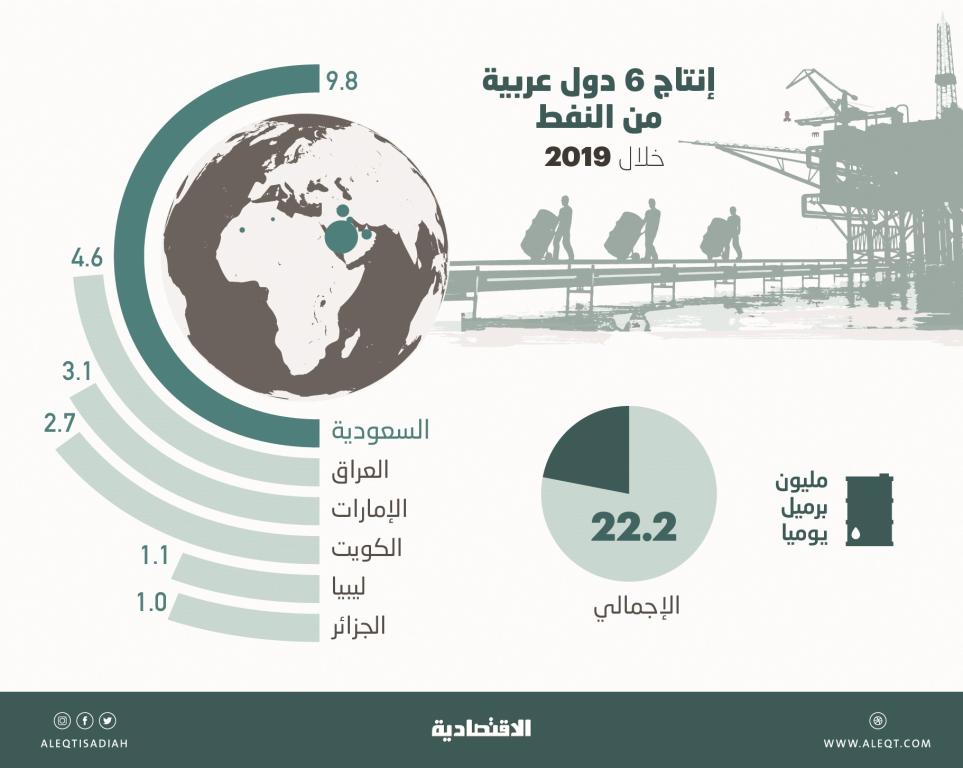
[ad_1]
Six Arab countries produced oil in the past year around 22.2 million barrels per day, led by Saudi Arabia, whose production reached 9.8 million barrels per day.
The six Arab oil-producing countries that are members of the Organization of the Petroleum Exporting Countries (OPEC) are: Saudi Arabia, Iraq, UAE, Kuwait, Libya and Algeria.
According to the analysis of the reporting unit in the Al-Eqtisadiah newspaper, based on OPEC data, the production of the six Arab countries in the year 2019 is equivalent to about 22.3% of the demand. world of crude the same year, estimated at 99.8 million barrels per day.
This comes despite the drop in production of the six countries of 1 percent (223 thousand barrels per day) during the year 2019, since it was 22.5 million barrels per day during the year 2018. .
The production of the six Arab countries is equivalent to 74.4 percent of “OPEC” production in 2019, which amounted to 29.9 million barrels per day.
The production of the six countries has declined due to adherence to the production reduction agreement that OPEC and independent countries outside have committed since the beginning of 2017 to restore the stability of the oil market in the world.
OPEC and independent producers outside the organization, led by Russia, have pledged to cut oil production by around 1.2 million barrels per day in 2019, as it was finally agreed to ” deepen the reduction to 1.7 million barrels per day until the end of the first quarter. from 2020.
The six Arab countries
Among the six countries, production decreased in three countries (Saudi Arabia, Kuwait and Algeria), while it increased in three other countries (Iraq, Emirates and Libya), while the end result of total production is a decrease of 1 percent.
Saudi Arabia topped the six Arab countries in terms of production volume of around 9.8 million barrels per day, compared to around 10.3 million barrels per day in 2018, a decline of 4.9%, or 509,000 barrels per day.
Second, Iraq recorded production estimated at 4.6 million barrels per day, up from around 4.4 million barrels per day in 2018, up 3.8 percent, or 166,000 barrels per day.
In third place is the United Arab Emirates with an estimated production of 3.05 million barrels per day, up from around three million barrels per day in 2018, up 1.7%, equivalent to 50,000 barrels per day. day.
Kuwait came in fourth, with an estimated production of 2.68 million barrels per day, up from 2.74 million barrels per day in 2018, a decrease of 2.2%, or 59,000 barrels per day.
Libya came in fifth with an estimated production of 1.1 million barrels per day, up from around 951 thousand barrels per day in 2018, an increase of 15.4%, or 146 thousand barrels per day.
The significant increase in Libyan production resulted in an improvement in the security situation in the country in 2019 compared to previous years, which saw major problems for the Libyan oil sector and its supplies.
Algeria came in sixth place with an estimated production of 1.02 million barrels per day, against around 1.04 million barrels per day in 2018, down 1.6%, or 17,000 barrels per day.
The development of Saudi production
As a result of changes in Saudi Arabia’s average daily output, it doubled about six times and increased by 498 percent during the period 1962 to 2019, with the average daily output in 1962 being around 1.64 million barrels per day.
Ten years after 1962, Saudi production topped six million barrels per day to 6.02 million barrels per day in 1972, then topped seven million barrels per day the following year to 7.60 million barrels per day. in 1973, then exceeded eight million barrels per day in 1973. the following year to reach 8.48 million barrels per day in 1974.
Two years later, Saudi Arabia’s production exceeded nine million barrels per day, reaching 9.20 million barrels per day in 1977, and since then until the end of 2014, production has not reached ten million barrels per day as the average annual production, but it exceeded it. in 2015 with a production of 10.19 million barrels per day.
In 2016, Saudi Arabia recorded a record annual production level of 10.46 million barrels per day, while production subsequently declined to 9.96 million barrels per day in 2017 due to the commitment in the “OPEC” agreement to reduce production in order to restore the stability of the oil market. in the world.
Saudi Arabia’s production rose again in 2018 to 10.32 million barrels per day, while it fell to 9.81 million barrels per day in 2019.
* Economic reports unit
Source link